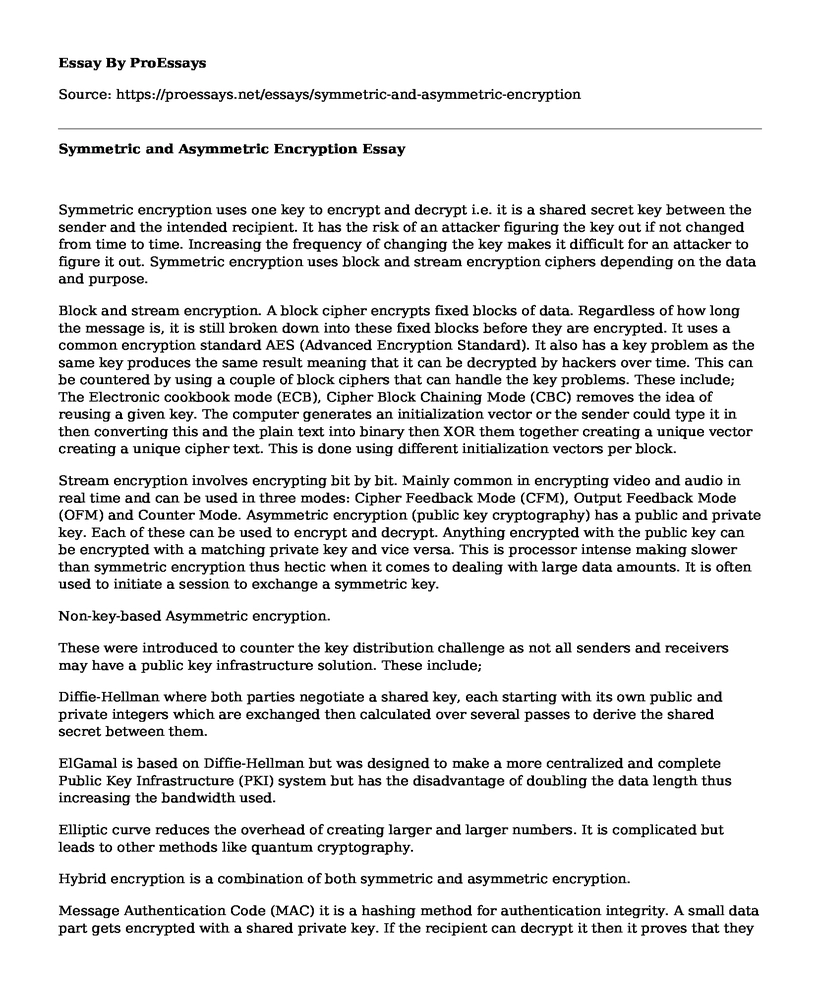Symmetric encryption uses one key to encrypt and decrypt i.e. it is a shared secret key between the sender and the intended recipient. It has the risk of an attacker figuring the key out if not changed from time to time. Increasing the frequency of changing the key makes it difficult for an attacker to figure it out. Symmetric encryption uses block and stream encryption ciphers depending on the data and purpose.
Block and stream encryption. A block cipher encrypts fixed blocks of data. Regardless of how long the message is, it is still broken down into these fixed blocks before they are encrypted. It uses a common encryption standard AES (Advanced Encryption Standard). It also has a key problem as the same key produces the same result meaning that it can be decrypted by hackers over time. This can be countered by using a couple of block ciphers that can handle the key problems. These include; The Electronic cookbook mode (ECB), Cipher Block Chaining Mode (CBC) removes the idea of reusing a given key. The computer generates an initialization vector or the sender could type it in then converting this and the plain text into binary then XOR them together creating a unique vector creating a unique cipher text. This is done using different initialization vectors per block.
Stream encryption involves encrypting bit by bit. Mainly common in encrypting video and audio in real time and can be used in three modes: Cipher Feedback Mode (CFM), Output Feedback Mode (OFM) and Counter Mode. Asymmetric encryption (public key cryptography) has a public and private key. Each of these can be used to encrypt and decrypt. Anything encrypted with the public key can be encrypted with a matching private key and vice versa. This is processor intense making slower than symmetric encryption thus hectic when it comes to dealing with large data amounts. It is often used to initiate a session to exchange a symmetric key.
Non-key-based Asymmetric encryption.
These were introduced to counter the key distribution challenge as not all senders and receivers may have a public key infrastructure solution. These include;
Diffie-Hellman where both parties negotiate a shared key, each starting with its own public and private integers which are exchanged then calculated over several passes to derive the shared secret between them.
ElGamal is based on Diffie-Hellman but was designed to make a more centralized and complete Public Key Infrastructure (PKI) system but has the disadvantage of doubling the data length thus increasing the bandwidth used.
Elliptic curve reduces the overhead of creating larger and larger numbers. It is complicated but leads to other methods like quantum cryptography.
Hybrid encryption is a combination of both symmetric and asymmetric encryption.
Message Authentication Code (MAC) it is a hashing method for authentication integrity. A small data part gets encrypted with a shared private key. If the recipient can decrypt it then it proves that they are the intended recipient. Steganography involves hiding data inside a picture by shifting its bits just a little bit without changing the picture.
Digital signatures and Non-repudiation
These are commonly used in e-mails to validate the senders detail. It provides proof of origin and provides proof of origin. Non-repudiation ensures that the message alterations can be traced back to their origin. It is asymmetric meaning that the users private key is used and it requires proper authentication. This provides proof of origin as the hash is encrypted with the senders public key. Non-repudiation is whereby a person cannot reasonably deny that they are responsible for the action or the message. Mainly used for auditing as the message alterations can be tracked back to the person that changed it. It becomes more difficult when multiple parties share the same key as it will be a challenge to know who sent the message unless auditing and logging capabilities are used to discern the non-repudiation.
Cite this page
Symmetric and Asymmetric Encryption. (2021, Mar 23). Retrieved from https://proessays.net/essays/symmetric-and-asymmetric-encryption
If you are the original author of this essay and no longer wish to have it published on the ProEssays website, please click below to request its removal:
- Hacking and Its Implication in the Modern World: Case Study Sample
- Data Mining and Predictive Analysis in Enhancing Innovation in Government
- Teens and the Internet: Annotated Bibliography
- Essay Sample on Role of SQL in Data Mining and Statistical Analysis
- Essay Sample on Protecting Image in Online Attack: Engage, Pre-empt & Diplomacy
- FBI's Battle Against Homegrown Violent Extremists (HVEs): Timothy McVeigh - Essay Sample
- Essay Example on Microsoft: Transforming Humanity's Future Through Cloud Tech







